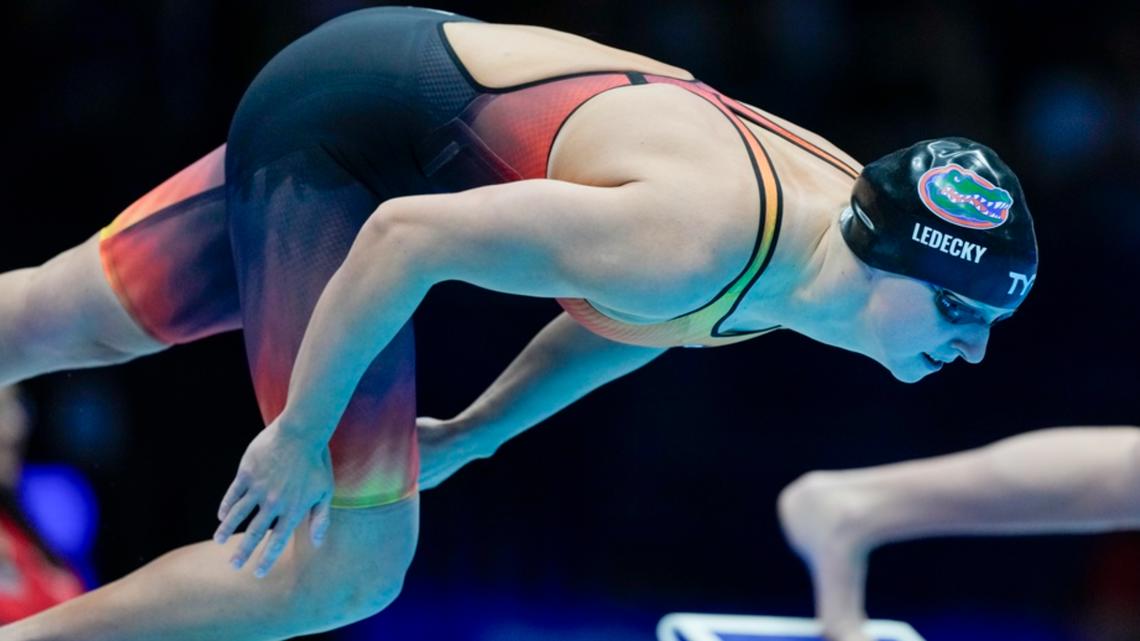After the Tokyo Games, Simone Manuel was forced to give up all activity for seven months — even something as mundane as a light stroll — to allow herself to heal.
ATLANTA — As Simone Manuel zig-zags her way through a cramped deck brimming with swimmers, she’s reminded there are still some things she finds annoying about her sport.
“I’m not sure a crowded pool deck is always the most fun,” she quips, breaking into a grin. “I don’t think any swimmer enjoys that too much.”
Not that she’s complaining.
Not after all she’s been through.
The first Black female swimmer to capture an individual Olympic gold medal, Manuel is coming back from a debilitating case of overtraining syndrome, her body breaking down in the leadup to the 2021 Tokyo Games after a starring turn five years earlier in Rio de Janeiro, where she claimed two golds and two silvers.
Manuel struggled just to make the U.S. team for Japan and only managed a bronze medal as anchor on the 4×100-meter freestyle relay. As soon as the flame was extinguished, she was forced to give up all activity for seven months — even something as mundane as a light stroll — to allow herself to heal both physically and mentally.
“It’s probably the most boring months of my life,” she told The Associated Press. “I spent a lot of time talking about my feelings, what happened, processing what happened, because I think when you’re in it, you’re kind of in survival mode. I really needed to process it and come to terms with everything.”
Heading into the U.S. Olympic trials, which begin Saturday in Indianapolis, Manuel finds herself in a much better place.
She’s as determined as ever to make her third Olympics, but she knows there are things far more important than touching the wall first.
Like making sure she’s taking care of herself.
It’s a lesson that an increasing number of high-level athletes — from fellow swimmer Caeleb Dressel to gold medal gymnast Simone Biles to tennis star Naomi Osaki — are heeding when overwhelmed by the demands of their sports.
“I’ve always been a person who likes to dream big, who has very aggressive goals,” said Manuel, who claimed her historic gold when she tied for the top spot in the 100 freestyle at the 2016 Rio Games. “It would be unfair of me to lower my standards. but at the same time, I do have to give myself grace because this journey is like no other that I’ve ever had in this sport.”


After her long, doctor-ordered layoff — which was accompanied by the inevitable doubts that she’d ever be a top-level swimmer again — Manuel looks like herself again in the pool.
The 27-year-old Texan turned in her best time in the 100 free since 2019 at a meet last month to set herself up as one of the top sprint contenders.
“I’m very pleased with where she’s at,” said one of her coaches, Bob Bowman, who is best known for his work with most decorated Olympian of them all, Michael Phelps. “She’s pretty close to her top level.”
Manuel moved to Arizona State University in suburban Phoenix to work with Bowman and his top assistant, Herbie Behm — a move that had a huge impact on her recovery.
“I just felt like when I met with Bob, I had a really good connection with him,” Manuel said. “He was really understanding of my experience with being overtrained, and that was extremely critical for me. I wanted to be able to talk with my new coach about that experience, what it was like for me, mentally and physically, and have them want to talk about it with me, but also understand what that was like and how they could help me moving forward.”
Bowman’s recognition of Manuel’s condition was in stark contrast to the lack of understanding — outside the sport and even at the pool — when she revealed her condition. Overtraining syndrome is a very real issue, but some felt she was just making excuses for her slumping performances ahead of Tokyo.
She even pondered walking away from the sport.
“I’ve accomplished a lot in this sport and I think that, to an extent, some of the responses to what happened to me weren’t completely gracious,” she said. “I think in my mind I was like, ‘I don’t have to put myself in a position to be vulnerable in front of the world again, just for them to not accept that what happened to me was real and that this is not an excuse.'”
Experts say overtraining syndrome — also known as burnout — is a very real concern for all top-level athletes, who must walk that very thin line between working harder than their competitors without reaching the point of diminishing returns.
Every body, even those that win gold medals, has its limits.
“It’s not giving the body enough time to recover from intense training that presents itself with fatigue and a lack of motivation,” said Dr. Paul Arciero, a professor in the Department of Sports Medicine and Nutrition at the University of Pittsburgh. “One of the tell-tale signs is a decline in performance.”
That’s just what happened to Manuel, who had always figured — like so many of her fellow athletes as well as coaches — that the only way to keep improving was to push her body even more. As the Tokyo Olympics approached, she couldn’t understand why her times kept getting worse and worse even though she felt like she was working harder than ever.
Dr. Robert Trasolini, an orthopedic surgeon and specialist in sports medicine at Northwell Health Orthopaedic Institute in New York, said Olympic athletes — who put in countless hours in pursuit of a goal that can only be reached every four years — are especially susceptible to overtraining syndrome.
“When you start to overreach and see a decline in activity, that should be the bell that says, ‘Hey, I need to stop,’” Trasolini said. “But that’s hard for an athlete who is working toward a goal, especially when there’s not that instant gratification.”
Proper nutrition and adequate recovery time are vital in preventing overtraining syndrome. It’s also imperative to have a coaching and support staff that can recognize the warning signs, which can turn up in everything from resting heart rate to blood pressure.
Arciero also recommends that every top-level athlete, who got where he or she is largely through single-minded focus, look for a pursuit that provides a sense of purpose away from the arena.


“It may be knitting, or reading, or doing some art,” he said.
To that end, Manuel has launched her own foundation to help expand swimming to Black communities and other groups that have largely been shut out of a sport that remains mostly white in the U.S.
She’s not trying to find the next Simone Manuel. She simply wants to expose more people of color to a lifestyle, to show them how much fun it is to spend a day in the water.
“We’re not going to see more diversity in the sport if it doesn’t start at the grassroots level,” Manuel said. “Swimming should be something that’s really positive within the Black community, but historically it hasn’t been.”
Bowman, who left Arizona State in April to take over the storied swimming program at the University of Texas, continues to work with Manuel as she prepares for the trials, though it’s now more of a long-distance relationship. She remained in Tempe to do the bulk of her training with Behm, who succeeded Bowman as the Sun Devils’ head coach.
Manuel is in a much better spot than she was three summers ago. She got married late last year. She’s swimming fast again.
“I’ve always been very in tune with my body in regards to swimming, but I’ve just learned it’s really important to take a breath,” Manuel said. “It’s really important to not just be in tune with your body, but really listen to it.”











